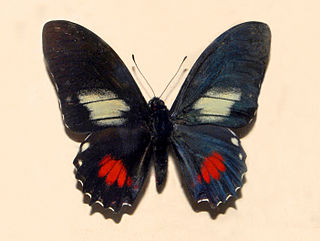
Papilio aegeus, the orchard swallowtail butterfly or large citrus butterfly is a species of butterfly from the family Papilionidae, that is found in eastern Australia and Papua New Guinea.

Papilio ulysses, the Ulysses butterfly, is a large swallowtail butterfly, in the subgenus Achillides, of Australia, Indonesia, Papua New Guinea and the Solomon Islands. Its size varies depending on subspecies, but the wingspan is about 10.5 cm (4.1 in) in Queensland.

Papilio weymeri is a species of swallowtail butterfly in the Papilioninae subfamily that is endemic to Papua New Guinea where it is found on Los Negros and Manus Islands.

Papilio scamander, the Scamander swallowtail, is a butterfly of the family Papilionidae. It is found from eastern and south-eastern Brazil south into Argentina.

Papilio torquatus, the torquatus swallowtail, is a swallowtail butterfly in the subfamily Papilioninae. It is found from northern Argentina to Mexico.

Papilio androgeus, the Androgeus swallowtail, queen page, or queen swallowtail, is a Neotropical butterfly of the family Papilionidae. It is found from Mexico to Argentina with a small population in southern Florida.

Papilio bridgei is a swallowtail butterfly of the Papilioninae subfamily. It is found on various islands in the Solomons group. It is not threatened.

Papilio cacicus is a Neotropical butterfly of the family Papilionidae first described by Hippolyte Lucas in 1852. It is found in Colombia, Venezuela, Ecuador and Peru.

Papilio zagreus is a butterfly of the family Papilionidae (swallowtails). It is found in South America, including Venezuela, Colombia, Ecuador, Peru, Bolivia and western Brazil.

Mimoides ariarathes is a species of butterfly in the family Papilionidae. It is native to South America.

Papilio birchallii is a species of Neotropical swallowtail butterfly from the genus Papilio that is found in Colombia, Panama and Costa Rica.

Papilio erskinei is a species of swallowtail butterfly from the genus Papilio that is found on Ugi Island.

Papilio gambrisius is a species of swallowtail butterfly from the genus Papilio that is found in Serang, Moluccas, Ambon Island, Seram and Buru.

Papilio inopinatus is a species of swallowtail butterfly from the genus Papilio that is found in Romang, Babar, Damar and Tanimbar.

Papilio ptolychus is a species of swallowtail butterfly from the genus Papilio that is found on Guadalcanal and Florida Island.

Papilio tydeus is a species of swallowtail butterfly from the genus Papilio that is found in the Moluccas.

Papilio nubilus is a rare species of swallowtail butterfly from the genus Papilio that can be found in Borneo.

Graphium hicetaon is a butterfly found in the Solomon Islands - Bougainville Island, Choiseul Island, Shortland Island, Florida Island, Guadalcanal, New Georgia Group and Ugi Island - that belongs to the swallowtail family.

Parides proneus is a species of butterfly in the family Papilionidae. It is found in Brazil and Paraguay.

Mimoides euryleon, the false cattleheart swallowtail, is a species of butterfly in the family Papilionidae.




















